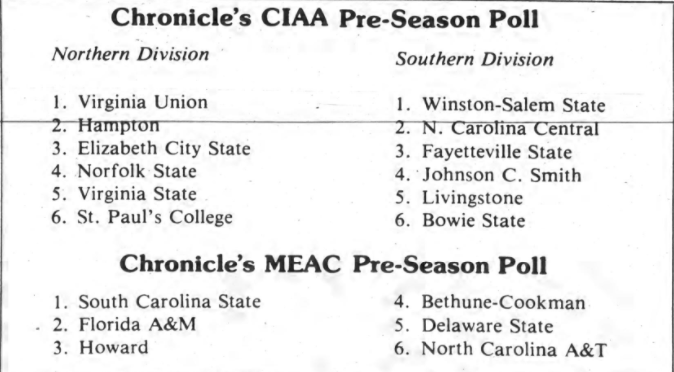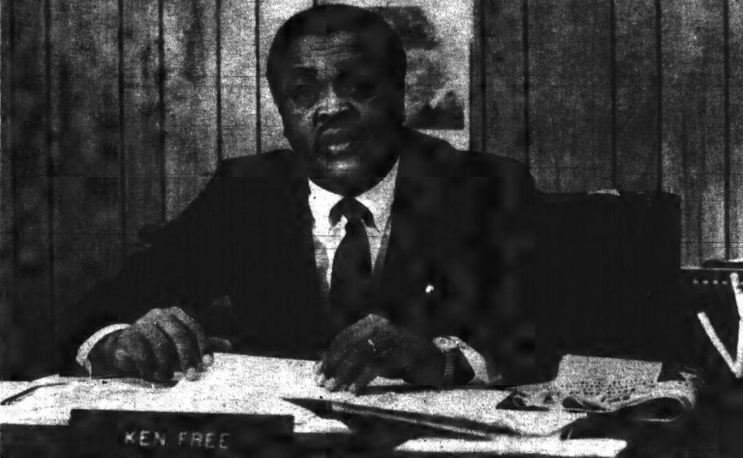The fall of 1979 was a scary time for the youthful Mid-Eastern Athletic Conference. Nearly ten years after six members of the Central Intercollegiate Athletic Association (CIAA), plus South Carolina State, decided to break away from the mother conference, it was facing the possibility of losing nearly half its membership.
Maryland Eastern-Shore, Morgan State and North Carolina Central decided they did not want the Division I status that the MEAC had been eyeing since its inception, and announced they would be leaving. UMES had already let its football program go, and in 1979 it dropped out of the conference and sought to reconcile with the CIAA. It was denied entry due to its lack of football and re-entered the conference in 1981.
Morgan State and NCCU announced they would be leaving after the 1980 school year.
[inArticle]
Suddenly, the league would be down to just four schools. MEAC Commissioner Ken Free spent much of his time in the Greensboro, NC office trying to reassure the conference’s remaining members (Delaware State, Howard, North Carolina A&T, South Carolina State) that the spoils of Division I would be
“Getting into Division I on a full scale is a matter of economics,” Free said. “The cost of football, plus fielding teams in a minimum of seven other sports, is prohibitive to a lot of schools.”

The South rises
Just when things were looking bleak for the conference, it got a ray of sunshine from Florida. Florida A&M, the 1978 Division I-AA champions, announced in August 1979 that it would be leaving the SIAC for a Division conference. A member of the second-oldest HBCU football conference for 66 years, the move came down to money and visibility and a desire to be Division I-AA in all sports. The decision was between the MEAC and SWAC, but ultimately FAMU decided to go north.
“The SWAC has the money and the teams, but the MEAC has a full-time commissioner, a full-time public relations man, a staffed office,” FAMU AD Hansel Tookes told the Tallahassee Democrat.
“There is no doubt this is quite a lift for the conference and gets us back up to six schools,” Free told The Morning News. “Now we can reach our objective of an automatic berth in the Division I playoffs and it can help us attract even more schools.”
By the early 1980s, the league was officially a part of Divison I, but things weren’t exactly smooth. The conference was given an automatic bid to the NCAA Men’s Basketball Tournament in 1981, which was claimed by Howard.
The football playoffs were another story, one that almost lost the conference FAMU. A 1983 scheduling conflict between FAMU and BCC, led to FAMU being declared ineligible for the title. FAMU’s ineligibility meant that the conference had only five teams
January 1984 was another turning point for the conference. Morgan State was re-admitted to the conference that year, which was good as it faced the real possibility of losing FAMU, and possibly even North Carolina A&T.
[postBannerAd]

I hate to say this but all the MEAC teams need to come back to the CIAA. The MEAC is a joke of a conference in every sport. I can see why Hampton left for the Big South. The only team that is making some noise is A&T and that’s only in football. You can’t blame it on visibility because we all see on ESPN when MEAC teams get smoked by the big boys. I honestly blame it on coaching and recruiting. You are going to tell me that a black kid would rather go to Univ. of Richmond, Detroit Mercy than FAMU or A&T to play a sport? Something is wrong with that picture.
KJ are you an HBCU graduate?
The short reference about the history of the MEAC 1978-80’s as unusual falls short in telling the impact of the true founders of who and why the conference was founded in
The first place. Please do your research. Dr. Leroy Walker
In his quest to to complete in Division 1 Track and Field at rtthe NCAA LEVEL ,INITIATIVE THE CONFERENCE .THE CONFERENCE OFFICE WAS IN DURHAM . TRACK , FOOTBALL AND BASKETBALL were apart of this process
South Carolina State Dominated the conference’ 1975- 80’x in all sports winning 16 of the leagues trophies for
Most championships in all sports . 2 AIAW NATIONAL CHAMPIONSHIP IN WOMEN TRACK AND WOMENS BASKETBALL, THREE HBCU CHAMPIONSHIPS IN FOOTBALL, 2 1AA PLAYSOFFS , ‘ 81 ’82, WON ALL THE
TENNIS AND WRESTLING CHAMPIONSHIPS , INDOOR AND OUTDOOR TRACK , ALL THE GOLF CHAMPIONSHIP SNCCU FINISHED 4 IN THE NCAA OUTDOOR TRACK AND FIELD CHAMPIONSHIP D1 ’74-75…… PLEASE DO YOU RESEARCH ……IT WAS MORE THAN FOOTBALL
So why should the MEAC schools join the CIAA? If they move down, why shouldn’t the conference as a whole move down and stay together?
Someone needs to proof read this article..
Great read. Truly appreciated
I couldn’t disagree with this article and comment above more. Would love to rap about it though.